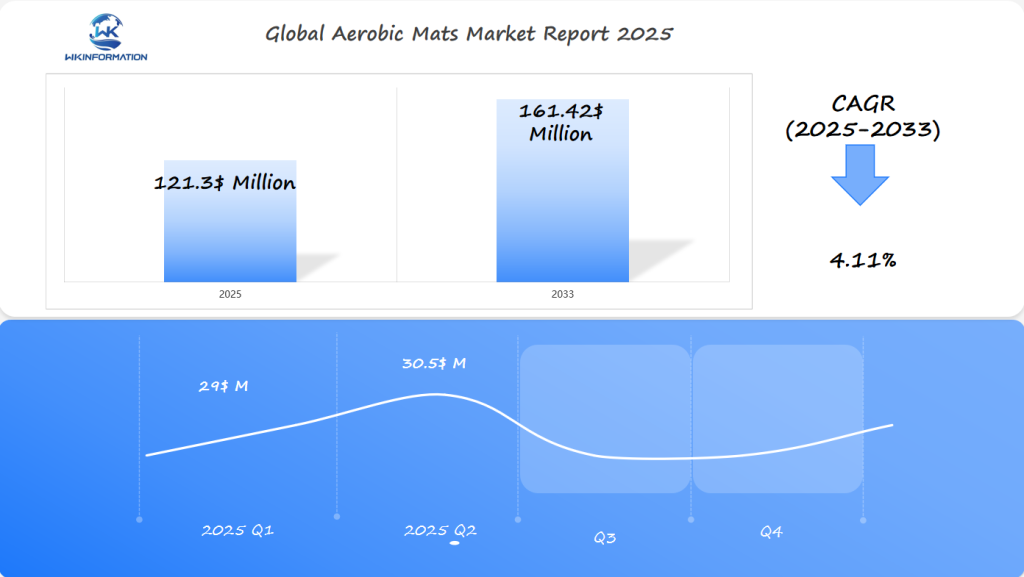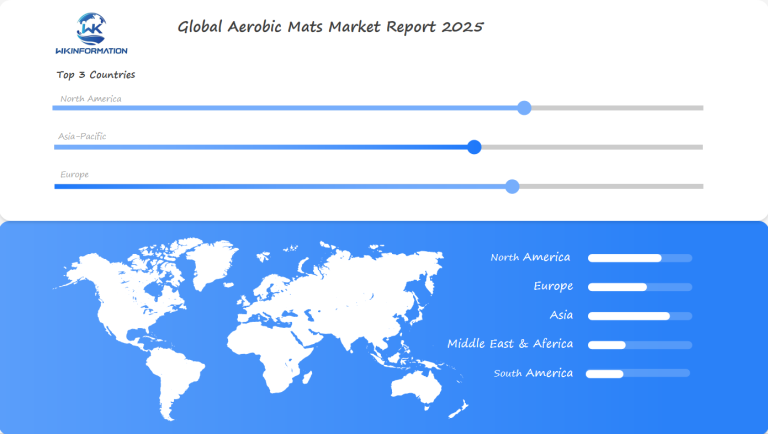Aerobic Mats Market 2025: Global Insights on U.S., China, and Germany Paving the Path to $121.3 Million Growth
Discover why the U.S., China, and Germany dominate the Aerobic Mats Market growth in this industry report.
- Last Updated:
Aerobic Mats Q1 and Q2 2025 Market Performance and Regional Demand
The Aerobic Mats market is expected to reach USD 121.3 million in 2025, growing at a CAGR of 4.11% from 2025 to 2033. Q1 2025 is projected at USD 29 million, while Q2 is expected to rise to USD 30.5 million, fueled by increasing consumer interest in home workouts, yoga, and fitness training.
The U.S., China, and Germany remain the dominant markets for aerobic mats. In the U.S., the fitness and wellness industry is witnessing strong growth, with a rising number of home gym enthusiasts and yoga practitioners driving demand. China’s growing health-conscious population and increasing participation in group fitness activities contribute to the expanding market for high-quality, eco-friendly exercise mats. Germany, known for its emphasis on sports and well-being, sees strong demand for durable and sustainable aerobic mats, particularly among gym facilities and personal trainers.

Key Takeaways
- Projected market value of $121.3 million by 2025
- Strong growth in U.S., China, and German markets
- Increasing health and fitness awareness driving demand
- Expanding fitness industry supporting market growth
- Rising interest in residential and commercial fitness solutions
Upstream and Downstream Influences in the Aerobic Mats Market
The aerobic mats market faces a complex supply chain. This chain affects its growth path towards a $121.3 million value by 2025. Raw materials are key, with makers choosing inputs that balance quality and cost.
Key elements of the supply chain include:
- Sourcing of high-quality synthetic and natural materials
- Manufacturing processes that optimize production efficiency
- Strategic distribution channels for market penetration
Distribution channels have changed a lot. They now use digital platforms and specialized fitness retail networks. This helps makers reach more customers, from home users to pro trainers.
| Supply Chain Component | Key Characteristics | Market Impact |
|---|---|---|
| Raw Materials | PVC, TPE, Rubber Composites | Cost Optimization |
| Manufacturing | Precision Molding Technologies | Product Quality Enhancement |
| Distribution | Online and Offline Retail | Market Expansion |
Technological progress in making is changing how materials are picked. Now, makers focus on materials that are long-lasting, eco-friendly, and perform well in different fitness settings.
Key Trends Shaping the Aerobic Mats Market in 2025
The aerobic mats market is changing fast, thanks to new tech and what people want. Fitness lovers are looking for better, greener workout gear. So, makers are coming up with new mat materials and designs.
Technological Advancements in Mat Materials
Companies are making mat materials better for workouts. They’re working on:
- Stronger polymers
- Smart tech for tracking
- Light but tough mats
“Innovation in mat materials is not just about performance, but about creating a holistic fitness experience.” – Fitness Technology Experts
Shift Towards Eco-Friendly and Sustainable Mats
More people want eco-friendly mats. They want to help the planet. So, makers are using:
- Recycled stuff
- Biodegradable mats
- Circular economy in making
Growing Demand for Multi-Functional Mats
People want mats that do it all. They’re looking for mats that work for yoga, Pilates, HIIT, strength training, and more. Modern mats are designed to fit different needs.
These trends show the market is changing fast. It’s all about better performance, being green, and being versatile.
Restrictions Affecting the Growth of the Aerobic Mats Market
The aerobic mats market is facing big challenges that might slow it down. Rules and regulations are a big part of this problem. They make it hard for companies to make and sell these mats.
Some major issues in the aerobic mats market include:
- Strict safety rules for fitness gear
- More competition from other makers
- Changes in the cost of raw materials
- Rules to protect the environment during making
There’s a lot of competition in the market. Many brands are trying to get people’s attention. Small companies find it tough to keep up with the costs of following these rules. This makes it hard for them to get into the market and come up with new ideas.
Rules focus a lot on safety, what the mats are made of, and how they affect the environment. Companies have to spend a lot on:
- Testing their products
- Keeping quality high
- Making things in a way that’s good for the planet
- Showing they follow the rules
Changes in the economy and how people spend money also make things harder for those making aerobic mats.

Geopolitical Factors Influencing the Aerobic Mats Market
The global aerobic mats market is changing fast because of complex international trade. Tensions and changes in market strategies are affecting how products are made and sold around the world.
- Increasing trade tensions between major economic powers
- Changing international trade policies
- Strategic shifts in global market dynamics
- Regional economic collaborations and restrictions
China’s economic plan has had a big impact. The country is focusing on its own market and making key products by itself. This change affects how aerobic mats are traded worldwide.
| Region | Market Impact | Trade Dynamics |
|---|---|---|
| United States | Strong domestic production | Protective tariff policies |
| China | Manufacturing hub | Domestic market focus |
| Germany | High-quality manufacturing | European Union trade regulations |
Trade barriers and tariffs are key in shaping the aerobic mats market. Companies must deal with tough rules while keeping prices and quality good.
Those who can adjust to changing global politics will likely do well in the aerobic mats business.
Segmentation Breakdown: Types and Materials of Aerobic Mats
The aerobic mats market has many types for different fitness needs. Knowing about each material helps athletes pick the best mat for their workouts.
People who work out and athletes need special mats for better workouts and safety. The global market for these mats is expected to hit $121.3 million by 2025. This shows more people want top-notch exercise surfaces.
PVC Mats: Durability and Affordability
PVC mats are a favorite in the fitness world because they’re affordable and last long. They have:
- Excellent moisture resistance
- High durability for repeated use
- Lightweight design
- Smooth surface for easy cleaning
TPE Mats: Eco-Friendly Innovation
TPE mats are loved by those who care about the environment. They offer:
- Recyclable materials
- Reduced carbon footprint
- Excellent shock absorption
- Hypoallergenic properties
Rubber Mats: Professional-Grade Performance
Rubber mats are top-notch for intense workouts and professional settings. They have:
- Exceptional shock absorption
- Maximum grip and stability
- Long-lasting durability
- Resistance to wear and tear
“Selecting the right mat can significantly impact workout effectiveness and personal comfort.” – Fitness Equipment Experts
Applications of Aerobic Mats: Fitness, Therapy, and Beyond
Aerobic mats have changed the game in fitness, going beyond just gyms. They are key in commercial gyms, home workouts, and therapy.
These mats are used in many ways:
- Fitness training in commercial gyms
- Physical rehabilitation programs
- Yoga and Pilates practice
- Strength training support
- Injury prevention and recovery
In healthcare, aerobic mats are a big deal. Physical therapists use them to help patients recover. The mats offer a soft surface that eases joint stress during exercises.
| Application Area | Primary Purpose | Key Benefits |
|---|---|---|
| Commercial Gyms | Group Fitness Classes | Impact absorption, comfort |
| Rehabilitation Centers | Patient Recovery | Low-impact exercise support |
| Home Fitness | Personal Workout Space | Versatility, compact design |
The global market for aerobic mats is expected to hit $121.3 million by 2025. This shows how these fitness tools are becoming more popular in different areas.
Regional Insights: Aerobic Mats Market Performance Across Regions
The global aerobic mats market shows different performances in various regions. Emerging markets are key in shaping the industry. They have big differences in market share and what people like to buy.
Key regions leading the aerobic mats market include:
- North America: Dominant market with high fitness awareness
- Asia Pacific: Fastest-growing regional market
- Europe: Sustainable product innovation hub
- Middle East and Africa: Emerging market with potential growth
Looking at regional markets, we see interesting trends. The Asia Pacific region has the most growth potential. This is because of fast urban growth and more people wanting to stay fit.
Emerging markets are becoming more important for aerobic mats makers. Countries like China, India, and Brazil are investing a lot in fitness. This opens up big chances for the market to grow.
The competitive scene shows that having a good regional strategy is key. It helps in getting more market share and driving new ideas in the aerobic mats field.

USA Aerobic Mats Market: Key Trends and Market Outlook
The United States aerobic mats market is growing fast.
USA market trends show a big move towards special fitness gear. Top companies are making advanced aerobic mats. These mats offer:
- Enhanced durability
- Improved cushioning
- Eco-friendly materials
- Multi-functional design
The health and wellness area is getting bigger. This opens up chances for makers of aerobic mats. Market research shows a growing need for top-notch fitness gear that supports many workout types.
People want aerobic mats that do more and are good for the planet. Brands that offer new, green products will likely win big in the U.S. fitness market.
China Aerobic Mats Market: Opportunities and Industry Developments
China’s aerobic mats market is growing fast. It’s becoming a major player in the global fitness equipment world. The industrial floor mats market shows great potential for Chinese makers. Urban fitness trends are fueling high demand.
Important changes in the China market include:
- A compound annual growth rate (CAGR) of over 10% in the fitness industry
- Increasing urban fitness center expansions
- Rising consumer awareness about health and wellness
Export trends look good for Chinese aerobic mat makers. The market has seen big improvements in product quality and design. This makes Chinese mats more competitive worldwide.
The Chinese fitness equipment market shows great resilience and innovation in aerobic mat production.
Manufacturing hubs in places like Guangdong and Zhejiang are pushing for better mat materials. These areas are working on eco-friendly and sustainable mats. They aim to meet both local and global market needs.
Online sales are key to market growth. E-commerce platforms account for about 30% of aerobic mat sales. This digital shift helps Chinese makers reach more customers easily.
Germany Aerobic Mats Market: Challenges and Future Growth
The German aerobic mats market is at a turning point. It faces tough market dynamics and strict European rules. Despite these hurdles, there are big chances for growth in fitness and wellness.
Some major challenges for the German aerobic mats market are:
- Stringent quality control standards
- Intense competition from international manufacturers
- Increasing environmental sustainability requirements
- Rising production costs
Germany’s market is full of innovation. Companies are using new materials and tech to stand out. Eco-friendly manufacturing processes are key in Europe.
New products are changing the game. Makers are creating mats that do more, like better cushioning and staying cool. These meet the need for top-notch, green fitness gear.
The market is expected to grow steadily. New trends show big chances in specific fitness areas. Places like rehab centers, home gyms, and pro training spots are where new mat solutions will thrive.
What's Next for the Aerobic Mats Market: Forecast for 2025
The global aerobic mats market is expected to grow a lot. It’s predicted to reach $121.3 million by 2025. This growth shows more people want fitness and wellness products everywhere.
Important trends are pushing the market forward. Places like the United States, China, and Germany are leading the way. Companies are making new designs and using green materials to attract customers and keep up with fitness trends.
- Market forecast suggests a compound annual growth rate of 4.11%
- Growth projections indicate expanding fitness and home workout markets
- Emerging technologies driving mat material innovations
Regional markets will shape the future of aerobic mats. North America will lead with new products. Asia will grow as people become more health-conscious.
Companies are working hard to make better, greener mats. The market is looking up, thanks to new tech and more people wanting to stay fit.
Competitor Analysis in the Aerobic Mats Market
Some of the top players in this race are:
-
Lululemon —— Canada
-
Manduka PROlite —— USA
-
Jade Yoga —— USA
-
Hugger Mugger Para Rubber —— USA
-
PrAna Revolutionary —— USA
-
Gaiam —— USA
-
Easyoga —— Taiwan
-
HATHAYOGA —— China
-
Kharma Khare —— USA
-
Hosa —— China
-
Yogabum —— UK
Overall
| Report Metric | Details |
|---|---|
| Report Name | Global Aerobic Mats Market Report |
| Base Year | 2024 |
| Segment by Type |
|
| Segment by Application |
|
| Geographies Covered |
|
| Forecast units | USD million in value |
| Report coverage | Revenue and volume forecast, company share, competitive landscape, growth factors and trends |
The aerobic mats market is going through big changes. It’s expected to grow a lot, reaching $121.3 million by 2025. This growth is thanks to more people focusing on health and wellness in the US, China, and Germany.
More people are joining fitness centers and setting up home gyms. They also care more about their health. These trends are pushing the market forward.
Investing in this area looks very promising. The market is moving towards using eco-friendly materials and mats that can do more than one thing. The global industrial floor mats market shows how connected health and safety products are.
People living in cities want better, more durable aerobic mats. They want mats that are good for the planet too. Online sales are making it easier to get these mats, opening up new ways to reach customers.
The market will keep growing as technology improves and fitness trends change. Companies that focus on new, green, and top-notch mats will do well. They’ll be ready to take advantage of new opportunities.
Global Aerobic Mats Market Report (Can Read by Free sample) – Table of Contents
Chapter 1: Aerobic Mats Market Analysis Overview
- Competitive Forces Analysis (Porter’s Five Forces)
- Strategic Growth Assessment (Ansoff Matrix)
- Industry Value Chain Insights
- Regional Trends and Key Market Drivers
- Aerobic Mats MarketSegmentation Overview
Chapter 2: Competitive Landscape
- Global Aerobic Mats players and Regional Insights
- Key Players and Market Share Analysis
- Sales Trends of Leading Companies
- Year-on-Year Performance Insights
- Competitive Strategies and Market Positioning
- Key Differentiators and Strategic Moves
Chapter 3: Aerobic Mats Market Segmentation Analysis
- Key Data and Visual Insights
- Trends, Growth Rates, and Drivers
- Segment Dynamics and Insights
- Detailed Market Analysis by Segment
Chapter 4: Regional Market Performance
- Consumer Trends by Region
- Historical Data and Growth Forecasts
- Regional Growth Factors
- Economic, Demographic, and Technological Impacts
- Challenges and Opportunities in Key Regions
- Regional Trends and Market Shifts
- Key Cities and High-Demand Areas
Chapter 5: Aerobic Mats Emerging and Untapped Markets
- Growth Potential in Secondary Regions
- Trends, Challenges, and Opportunities
Chapter 6: Product and Application Segmentation
- Product Types and Innovation Trends
- Application-Based Market Insights
Chapter 7: Aerobic Mats Consumer Insights
- Demographics and Buying Behaviors
- Target Audience Profiles
Chapter 8: Key Findings and Recommendations
- Summary of Aerobic Mats Market Insights
- Actionable Recommendations for Stakeholders

Access the study in MULTIPLEFORMATS
Didn’t find what you’re looking for?
TALK TO OUR ANALYST TEAM
Need something within your budget?
NO WORRIES! WE GOT YOU COVERED!
Call us on: +1-866-739-3133
Email: infor@wkinformation.com
What is the projected market size for aerobic mats by 2025?
The global market for aerobic mats is expected to hit $121.3 million by 2025. The United States, China, and Germany are expected to lead the growth.
What materials are commonly used in aerobic mats?
Aerobic mats often use PVC, TPE, and rubber. Each material has its own strengths like durability and comfort.
Are there eco-friendly options for aerobic mats?
Yes, there’s a rise in eco-friendly mats. Manufacturers are working on green options for those who care about the environment.
What are the applications of aerobic mats beyond traditional fitness?
Aerobic mats are used in physical therapy, rehab centers, and home gyms. They’re also key in healthcare and wellness.
How are geopolitical factors impacting the aerobic mats market?
Trade policies, tariffs, and global markets affect aerobic mats’ production, distribution, and prices. This is especially true in the U.S., China, and Germany.
What trends are driving growth in the aerobic mats market?
Trends include better mat materials, multi-functional designs, and a focus on comfort and performance. There’s also a growing need for versatile exercise gear.
What challenges does the aerobic mats market face?
Challenges include fierce competition, safety regulations, and price swings in raw materials. Economic factors can also affect fitness equipment sales.
Which regions are showing the most potential for aerobic mats market growth?
The U.S., China, and Germany are expected to lead in growth. Each region has its own market dynamics and consumer preferences.
What should consumers consider when purchasing an aerobic mat?
Look at the material, durability, comfort, and thickness. Also, think about the intended use and if it’s sustainable.

